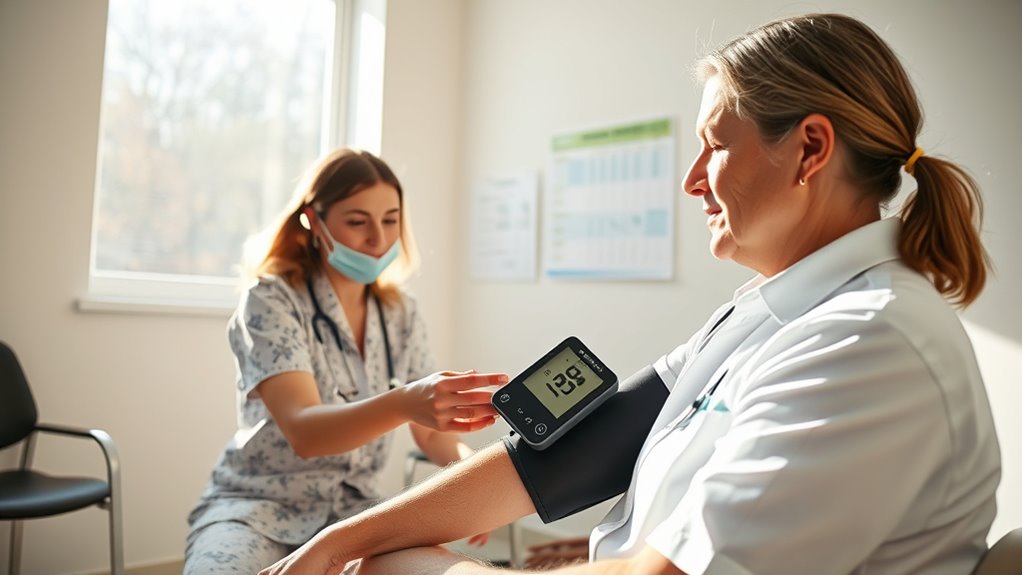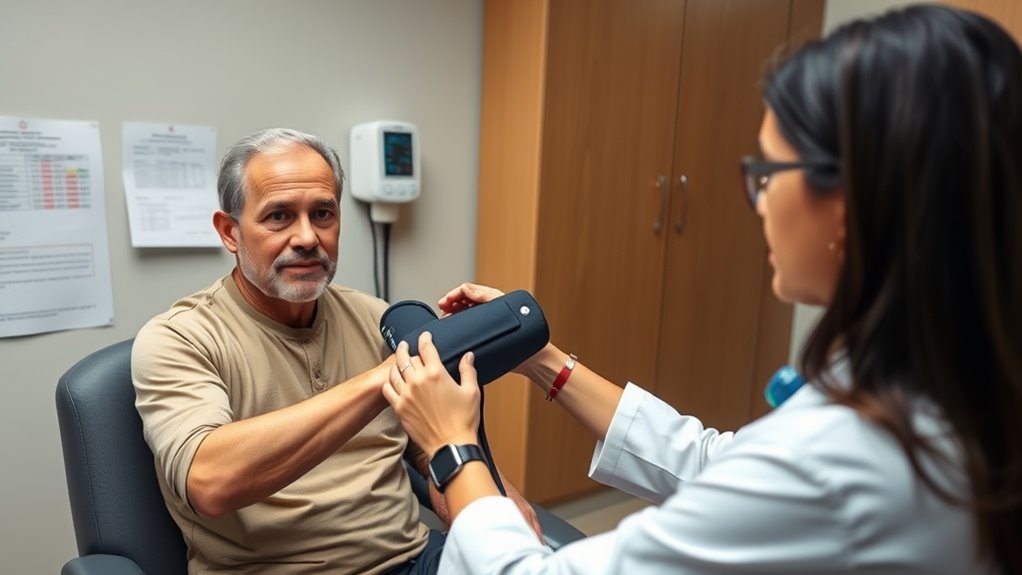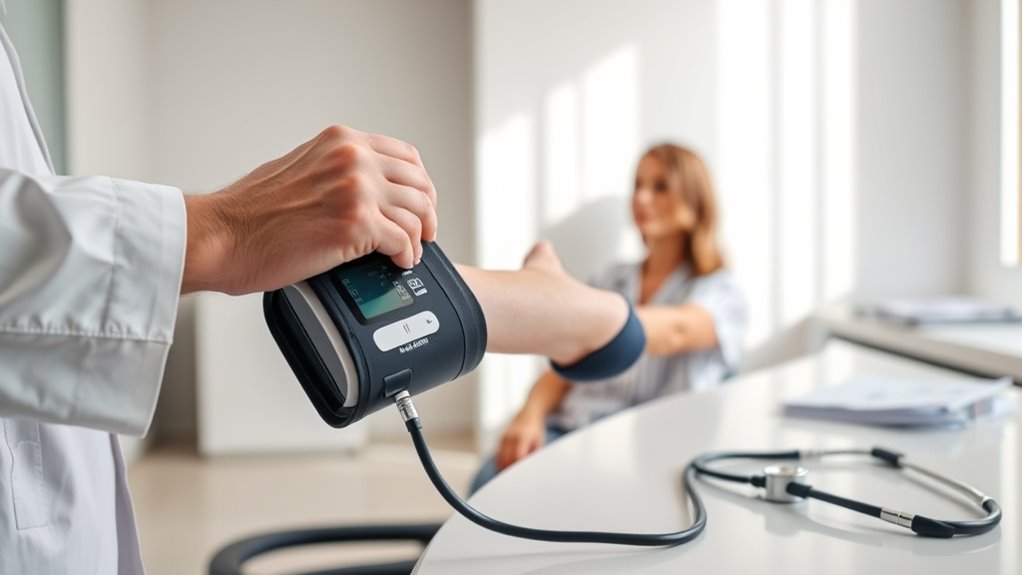To manage white coat hypertension during clinic visits, focus on proper measurement techniques, including using correctly sized cuffs, positioning your arm at heart level, and resting beforehand. Regularly monitor your blood pressure at home with validated devices, and consider 24-hour ambulatory monitoring to confirm your levels. Educating yourself about stress triggers and practicing relaxation can help reduce anxiety. If you keep these steps in mind, you’ll be better equipped to distinguish true hypertension from temporary spikes—learn more to take effective control.
Key Takeaways
- Use validated, properly calibrated blood pressure devices and ensure correct cuff size and patient positioning during clinic measurements.
- Encourage patients to perform home blood pressure monitoring to differentiate white coat effects from true hypertension.
- Schedule multiple readings over several visits to confirm consistent blood pressure elevations before diagnosis or treatment adjustments.
- Create a calm, reassuring environment during clinic visits to reduce patient anxiety that may artificially raise BP.
- Consider ambulatory blood pressure monitoring (ABPM) for comprehensive assessment of blood pressure patterns outside the clinic.
Recognizing the Signs of White Coat Hypertension

Have you ever noticed your blood pressure readings spike only during doctor visits? This is a common sign of white coat hypertension. Anxiety triggers, like sitting in a clinical environment or anticipating a diagnosis, can cause temporary increases in blood pressure. Recognizing these signs starts with patient education—understanding that stress in medical settings can elevate your readings helps you differentiate between true hypertension and white coat effects. Pay attention to how you feel during appointments; if your blood pressure rises only in the clinic and not at home, that’s a key indicator. Effective patient education empowers you to communicate these patterns with your healthcare provider, ensuring accurate diagnosis and appropriate management. Being aware of these signs helps prevent unnecessary treatment and anxiety. Additionally, utilizing home blood pressure monitoring can provide a more comprehensive picture of your blood pressure patterns outside of clinical visits.
Utilizing Proper Blood Pressure Measurement Techniques

To get accurate blood pressure readings, you need to use the correct cuff size and make certain the patient has a rest period before measurement. Following a standardized technique helps reduce errors and improves reliability. Paying attention to these details is essential for managing white coat hypertension effectively, and understanding privacy policies and cookie management can help ensure patient data is handled securely.
Use Proper Cuff Size
Using the correct cuff size is essential for accurate blood pressure readings, especially when managing white coat hypertension. An ill-fitting cuff can lead to falsely high or low readings, skewing your assessment. Always select a cuff that fits snugly around the patient’s arm without constricting it. Proper arm positioning is equally important: keep the arm at heart level, supported, and relaxed. Ensure the cuff’s bladder covers at least 80% of the arm’s circumference for precise measurement. Avoid wrapping the cuff too loose or too tight, as this affects the reading. Confirm the cuff size before measurement and adjust as needed. Accurate cuff size and arm positioning help eliminate measurement errors, providing reliable data for effective hypertension management. Additionally, understanding the principles of blood pressure measurement techniques can further improve the accuracy of your readings.
Ensure Patient Rest Periods
Ensuring the patient rests quietly for at least five minutes before taking a blood pressure reading is essential for accurate results. During this time, focus on promoting patient relaxation and stress management, which help prevent elevated readings caused by anxiety. Encourage the patient to sit comfortably with feet flat on the floor, back supported, and arm at heart level. Remind them to avoid talking or moving, as any activity can raise blood pressure temporarily. A calm environment reduces stress and allows blood pressure to stabilize. Additionally, using proper blood pressure measurement techniques ensures consistency across readings. By prioritizing these rest periods, you guarantee more reliable measurements, reducing the risk of misdiagnosis due to white coat effects. Consistent patient relaxation before measurement is a simple yet vital step in effective blood pressure management.
Follow Standardized Technique
After confirming the patient is relaxed and seated properly, applying a standardized blood pressure measurement technique guarantees accurate and consistent results. Make certain the patient is seated with their back supported and feet flat on the floor, and their arm at heart level. Use appropriately sized blood pressure cuffs to fit snugly without constricting blood flow. Position the cuff’s lower edge about an inch above the brachial artery, and keep the patient’s arm supported and still during measurement. Instruct the patient to breathe normally and avoid talking. Follow a consistent procedure for each reading, including waiting a minute between measurements. Proper patient positioning and correct cuff placement are essential for reliable blood pressure readings, reducing variability and minimizing white coat effects. Additionally, ensuring the proper environment free from external disturbances can further improve the accuracy of blood pressure readings.
Incorporating Ambulatory Blood Pressure Monitoring

Incorporating Ambulatory Blood Pressure Monitoring (ABPM) into the management of white coat hypertension provides a more accurate picture of your patient’s blood pressure outside the clinical setting. ABPM helps distinguish true hypertension from white coat effects, guiding appropriate treatment. When using ABPM, focus on educating your patient about the importance of maintaining a healthy lifestyle, including diet modifications and lifestyle counseling, to support blood pressure control. Additionally, understanding the seasonal variations in blood pressure can help in scheduling monitoring and tailoring treatment plans effectively. Key points include: – Scheduling ABPM to capture a full 24-hour cycle – Identifying patterns like nocturnal hypertension – Reinforcing the significance of consistent medication adherence – Using results to tailor lifestyle recommendations effectively
This approach ensures you’re not over-treating or under-treating, leading to better patient outcomes.
Employing Home Blood Pressure Monitoring Strategies

To get accurate readings at home, you need to use proper technique, like sitting quietly for a few minutes before measuring. Establishing a consistent schedule helps track your blood pressure trends over time. Using validated blood pressure monitors can also improve accuracy and reliability of your readings. By following these strategies, you can better manage white coat hypertension and share reliable data with your healthcare provider.
Proper Technique Tips
Using proper technique is essential for accurate home blood pressure monitoring. To get reliable readings, follow these tips:
- Rest for 5 minutes before measuring, sitting with your back supported and feet flat on the floor.
- Keep your arm at heart level, supporting it with a table if needed.
- Avoid caffeine, exercise, or smoking 30 minutes before measuring.
- Take two readings, one minute apart, and record the average.
- Ensure your blood pressure cuff is properly fitted and positioned for accurate results.
Consistent technique helps you track your blood pressure accurately, supporting your healthcare provider’s advice on blood pressure medications and lifestyle modifications. Proper monitoring guarantees you don’t underestimate or overestimate your blood pressure, leading to better management of your condition. Remember, accurate readings empower you to make informed decisions about your health.
Consistent Monitoring Schedule
Establishing a consistent monitoring schedule is essential for accurately tracking your blood pressure over time. By measuring regularly at home, you can identify patterns and determine if your blood pressure remains controlled, especially when taking blood pressure medications or implementing lifestyle modifications. Aim to measure your blood pressure twice daily, morning and evening, using proper technique. Consistency helps differentiate between white coat effects and true hypertension. Keep a detailed log of your readings to share with your healthcare provider, who can adjust medications or recommend further lifestyle modifications if necessary. Staying committed to this schedule guarantees you’re actively managing your blood pressure and reducing the risk of complications associated with white coat hypertension. Additionally, understanding the effects of anxiety and stress on blood pressure can help you interpret fluctuations more accurately.
Differentiating Between White Coat and True Hypertension

How can you tell if elevated blood pressure readings are due to white coat hypertension or a true underlying condition? One way is to look for patterns across different settings. Consider cultural influences that may cause anxiety in clinical environments, affecting readings. Dietary considerations, like high salt intake, can also elevate blood pressure outside the clinic. To differentiate, you might:
- Use ambulatory blood pressure monitoring over 24 hours
- Compare readings taken at home with those in the clinic
- Assess if anxiety or discomfort correlates with higher readings
- Review lifestyle factors, including diet and stress levels
Adjusting Treatment Plans Based on Accurate Readings

Accurate blood pressure readings are essential for effective treatment adjustments, especially when distinguishing between white coat and true hypertension. When readings are confirmed as consistent and elevated outside the clinical setting, you can confidently modify your treatment plan. Lifestyle modifications, such as reducing salt intake, increasing physical activity, and managing stress, should be emphasized to help lower blood pressure naturally. If medication is necessary, consider adjustments to optimize control without causing side effects. Regular monitoring ensures that changes are effective and that blood pressure remains within target ranges. Remember, relying on precise, validated readings helps you avoid unnecessary medication changes or overtreatment. Tailoring your treatment based on accurate data improves outcomes and minimizes the risk of complications associated with hypertension. Incorporating accurate measurement techniques ensures that treatment decisions are based on reliable information.
Educating Patients About Blood Pressure Variability

Understanding blood pressure variability is essential because it helps you and your healthcare provider interpret your readings accurately. Many blood pressure myths can cause unnecessary patient anxiety, making it harder to get reliable measurements. Educating yourself about normal fluctuations can reduce worry and improve your understanding. Keep in mind that blood pressure changes throughout the day due to activity, stress, or even posture.
To help, consider these points:
- Blood pressure naturally varies; not every high reading indicates a problem.
- Anxiety can temporarily raise readings; relaxation techniques help.
- Accurate readings depend on proper measurement techniques.
- Consistent monitoring provides a clearer picture of your blood pressure trends.
Understanding these factors empowers you to manage your health effectively and avoid misconceptions.
Addressing Psychological Factors That Influence Readings

Psychological factors such as stress, anxiety, and even anticipation can considerably influence your blood pressure readings. These psychological influences often cause temporary spikes, leading to elevated measurements that don’t reflect your true blood pressure. Patient anxiety, especially during clinic visits, can heighten your stress response, resulting in higher readings. To address this, create a calm environment, explain procedures clearly, and encourage relaxation techniques like deep breathing. Building trust and reducing uncertainty can help minimize patient anxiety, ultimately leading to more accurate readings. Recognizing the impact of psychological influences allows you to differentiate between true hypertension and stress-induced elevations. By actively managing these factors, you improve the reliability of your blood pressure assessments and ensure better diagnosis and treatment decisions.
Implementing Follow-Up Protocols for Accurate Assessment

Implementing follow-up protocols is essential to distinguish white coat hypertension from true high blood pressure. To do this effectively, consider the home environment, where blood pressure readings are less influenced by clinical anxiety. Encourage patients to monitor their blood pressure regularly at home, ideally at the same times each day, paying attention to medication timing. This consistency helps identify patterns and verify if elevated readings are isolated to clinic visits. You can also schedule periodic follow-ups to review home measurements and adjust treatment plans accordingly. Additionally, instruct patients on proper measurement techniques to ensure accuracy. By integrating these steps, you improve assessment reliability, reduce misdiagnosis, and develop targeted management strategies for your patients.
Frequently Asked Questions
How Common Is White Coat Hypertension Among Different Age Groups?
White coat hypertension varies across age groups, with younger individuals often experiencing it more due to anxiety, while older adults may have higher baseline blood pressure. Demographic variations also influence prevalence, as factors like gender, ethnicity, and health status play roles. You might notice that it’s more common in certain age-related populations, making it important to evaluate these variations when gauging blood pressure readings to avoid misdiagnosis or unnecessary treatment.
Can Lifestyle Changes Reduce White Coat Hypertension Episodes?
You can often reduce white coat hypertension episodes through lifestyle changes. Stress reduction techniques like deep breathing or meditation help ease anxiety during appointments. Dietary modifications, such as reducing salt intake and eating more fruits and vegetables, support overall blood pressure health. These steps can lower your anxiety levels and blood pressure spikes in clinical settings, making your readings more accurate and less influenced by the white coat effect.
Are There Specific Medications Recommended for White Coat Hypertension?
Think of medication efficacy for white coat hypertension as using a gentle rain shower instead of a storm—it’s about control, not chaos. According to treatment guidelines, specific medications like ACE inhibitors or calcium channel blockers may help, but they aren’t always necessary. Your healthcare provider evaluates your overall health, and treatment varies. Ultimately, they tailor medications to keep your blood pressure steady without unnecessary side effects.
How Does Anxiety During Visits Affect Blood Pressure Readings?
Anxiety triggers during visits can cause blood pressure fluctuations, making readings higher than usual. When you’re anxious, your body releases stress hormones, which elevate blood pressure temporarily. This can lead to inaccurate assessments of your true level. To reduce this effect, try deep breathing or relaxation techniques before measurements. Being aware of how anxiety impacts your readings helps you and your healthcare provider interpret results more accurately, ensuring better hypertension management.
What Are the Long-Term Risks Associated With Untreated White Coat Hypertension?
Untreated white coat hypertension can increase your cardiovascular risk over time, raising chances of heart disease and stroke. It may also have renal implications, potentially damaging your kidneys if high blood pressure persists unnoticed. Ignoring these elevated readings could lead to more serious health issues down the line. So, it’s important to monitor and manage your blood pressure regularly to prevent long-term complications.
Conclusion
By understanding and addressing white coat hypertension, you can avoid unnecessary medication and guarantee accurate blood pressure management. Some might think monitoring is too time-consuming, but integrating simple techniques like home and ambulatory checks saves you time and prevents misdiagnosis. Prioritizing accurate readings helps you make better treatment decisions, ultimately protecting your health. Don’t let anxiety or false readings hold you back—taking control now leads to better outcomes tomorrow.








